Emily Thomas

Emily Thomas
More Posts from Monstrous-mind and Others

Ten interesting facts about Jupiter
Here is a list of some interesting facts about the planet Jupiter. A planet that catches the attention of all, by its size, storms and its surprising moons.

The mass of Jupiter is 318 times as massive as the Earth. In fact, Jupiter is 2.5 times more massive than all of the other planets in the Solar System combined.

Its gravity is so strong that a rocket would have to go an unthinkable 135,000 mph to leave.

The Great Red Spot on Jupiter is one of its most familiar features. This persistent anticyclonic storm, which is located south of its equator, measures between 24,000 km in diameter and 12–14,000 km in height. As such, it is large enough to contain two or three planets the size of Earth’s diameter. And the spot has been around for at least 350 years, since it was spotted as far back as the 17th century.

Jupiter’s rings were discovered in 1979 by the passing Voyager 1 spacecraft, but their origin was a mystery. Data from the Galileo spacecraft that orbited Jupiter from 1995 to 2003 later confirmed that these rings were created by meteoroid impacts on small nearby moons.

Extending up to seven million kilometers in the Sun’s direction and almost to the orbit of Saturn in the opposite direction, Jupiter’s magnetosphere is the largest and most powerful of any planetary magnetosphere in the Solar System, and by volume the largest known continuous structure in the Solar System after the heliosphere.

Jupiter has a total of 69 natural satellites. The four largest are: Io, Europa, Ganymede and Callisto. However, it is estimated that the planet has over 200 natural satellites orbiting it. Almost all of them are less than 10 kilometers in diameter, and were only discovered after 1975, when the first spacecraft (Pioneer 10) arrived at Jupiter.

Jupiter Has Been Visited 8 Times By Spacecraft. Jupiter was first visited by NASA’s Pioneer 10 spacecraft in December 1973, and then Pioneer 11 in December 1974. Then came the Voyager 1 and 2 flybys, both of which happened in 1979. This was followed by a long break until Ulysses arrived in February 1992, followed by the Galileo space probe in 1995. Then Cassini made a flyby in 2000, on its way to Saturn. And finally, NASA’s New Horizons spacecraft made its flyby in 2007. NASA’s Juno spacecraft is currently orbiting Jupiter.

Jupiter is the third brightest object in the Solar System, after Venus and the Moon.

Jupiter Is The Fastest Spinning Planet In The Solar System. For all its size and mass, Jupiter sure moves quickly. In fact, with an rotational velocity of 12.6 km/s (~7.45 m/s) or 45,300 km/h (28,148 mph), the planet only takes about 10 hours to complete a full rotation on its axis. And because it’s spinning so rapidly, the planet has flattened out at the poles a little and is bulging at its equator.

Jupiter Cannot Become A Star. Astronomers call Jupiter a failed star, but that’s not really an appropriate description. While it is true that, like a star, Jupiter is rich in hydrogen and helium, Jupiter does not have nearly enough mass to trigger a fusion reaction in its core. This is how stars generate energy, by fusing hydrogen atoms together under extreme heat and pressure to create helium, releasing light and heat in the process.
This is made possible by their enormous gravity. For Jupiter to ignite a nuclear fusion process and become a star, it would need more than 70 times its current mass. If you could crash dozens of Jupiters together, you might have a chance to make a new star. But in the meantime, Jupiter shall remain a large gas giant with no hopes of becoming a star. Sorry, Jupiter!
Sources: universetoday and wikipedia
Images credits: Wikimedia Commons, JAXA, NASA, ESA, Hubble, Wang Letian & Michael Carroll

cozy autumn days
List of extrasolar candidates for liquid water
The following list contains candidates from the list of confirmed objects that meet the following criteria:
Confirmed object orbiting within a circumstellar habitable zone of Earth mass or greater (because smaller objects may not have the gravitational means to retain water) but not a star
Has been studied for more than a year
Confirmed surface with strong evidence for it being either solid or liquid
Water vapour detected in its atmosphere
Gravitational, radio or differentation models that predict a wet stratum
55 Cancri f

With a mass half that of Saturn, 55 Cancri f is likely to be a gas giant with no solid surface. It orbits in the so-called “habitable zone,” which means that liquid water could exist on the surface of a possible moon. ]
Proxima Centauri b

Proxima Centauri b is an exoplanet orbiting in the habitable zone of the red dwarfstar Proxima Centauri, which is the closest star to the Sun and part of a triple star system. It is located about 4.2 light-years from Earth in the constellation of Centaurus, making it the closest known exoplanet to the Solar System.
Gliese 581c

Gliese 581c gained interest from astronomers because it was reported to be the first potentially Earth-like planet in the habitable zone of its star, with a temperature right for liquid water on its surface, and by extension, potentially capable of supporting extremophile forms of Earth-like life.
Gliese 667 Cc

Gliese 667 Cc is an exoplanet orbiting within the habitable zone of the red dwarf star Gliese 667 C, which is a member of the Gliese 667 triple star system, approximately 23.62 light-years away in the constellation of Scorpius.
Gliese 1214 b

Gliese 1214 b is an exoplanet that orbits the star Gliese 1214, and was discovered in December 2009. Its parent star is 48 light-years from the Sun, in the constellation Ophiuchus. As of 2017, GJ 1214 b is the most likely known candidate for being an ocean planet. For that reason, scientists have nicknamed the planet “the waterworld”.
HD 85512 b

HD 85512 b is an exoplanet orbiting HD 85512, a K-type main-sequence star approximately 36 light-years from Earth in the constellation of Vela.
Due to its mass of at least 3.6 times the mass of Earth, HD 85512 b is classified as a rocky Earth-size exoplanet (<5M⊕) and is one of the smallest exoplanets discovered to be just outside the inner edge of the habitable zone.
MOA-2007-BLG-192Lb

MOA-2007-BLG-192Lb, occasionally shortened to MOA-192 b, is an extrasolar planet approximately 3,000 light-years away in the constellation of Sagittarius. The planet was discovered orbiting the brown dwarf or low-mass star MOA-2007-BLG-192L. At a mass of approximately 3.3 times Earth, it is one of the lowest-mass extrasolar planets at the time of discovery. It was found when it caused a gravitational microlensing event on May 24, 2007, which was detected as part of the MOA-II microlensing survey at the Mount John University Observatory in New Zealand.
Kepler-22b

Kepler-22b, also known by its Kepler object of interest designation KOI-087.01, is an extrasolar planet orbiting within the habitable zone of the Sun-like star Kepler-22. It is located about 587 light-years (180 pc) from Earth in the constellation of Cygnus. source
🔭🌃🌌🐈

Located over 50 million light years away, the large, distorted spiral NGC 1532 is seen locked in a gravitational struggle with dwarf galaxy NGC 1531 (right of center), a struggle the smaller galaxy will eventually lose.
Image Credit: Michel Meunier, Laurent Bernasconi, Janus Team
🌌☄️🌃🍂🍁

2024 August 14
Meteors and Aurora over Germany Image Credit & Copyright: Chantal Anders
Explanation: This was an unusual night. For one thing, the night sky of August 11 and 12, earlier this week, occurred near the peak of the annual Perseid Meteor Shower. Therefore, meteors streaked across the dark night as small bits cast off from Comet Swift-Tuttle came crashing into the Earth’s atmosphere. Even more unusually, for central Germany at least, the night sky glowed purple. The red-blue hue was due to aurora caused by an explosion of particles from the Sun a few days before. This auroral storm was so intense that it was seen as far south as Texas and Italy, in Earth’s northern hemisphere. The featured image composite was built from 7 exposures taken over 26 minutes from Ense, Germany. The Perseids occur predictably every August, but auroras visible this far south are more unusual and less predictable.
∞ Source: apod.nasa.gov/apod/ap240814.html
10 Things: Calling All Pluto Lovers
June 22 marks the 40th anniversary of Charon’s discovery—the dwarf planet Pluto’s largest and first known moon. While the definition of a planet is the subject of vigorous scientific debate, this dwarf planet is a fascinating world to explore. Get to know Pluto’s beautiful, fascinating companion this week.
1. A Happy Accident

Astronomers James Christy and Robert Harrington weren’t even looking for satellites of Pluto when they discovered Charon in June 1978 at the U.S. Naval Observatory Flagstaff Station in Arizona – only about six miles from where Pluto was discovered at Lowell Observatory. Instead, they were trying to refine Pluto’s orbit around the Sun when sharp-eyed Christy noticed images of Pluto were strangely elongated; a blob seemed to move around Pluto.
The direction of elongation cycled back and forth over 6.39 days―the same as Pluto’s rotation period. Searching through their archives of Pluto images taken years before, Christy then found more cases where Pluto appeared elongated. Additional images confirmed he had discovered the first known moon of Pluto.
2. Forever and Always

Christy proposed the name Charon after the mythological ferryman who carried souls across the river Acheron, one of the five mythical rivers that surrounded Pluto’s underworld. But Christy also chose it for a more personal reason: The first four letters matched the name of his wife, Charlene. (Cue the collective sigh.)
3. Big Little Moon

Charon—the largest of Pluto’s five moons and approximately the size of Texas—is almost half the size of Pluto itself. The little moon is so big that Pluto and Charon are sometimes referred to as a double dwarf planet system. The distance between them is 12,200 miles (19,640 kilometers).
4. A Colorful and Violent History

Many scientists on the New Horizons mission expected Charon to be a monotonous, crater-battered world; instead, they found a landscape covered with mountains, canyons, landslides, surface-color variations and more. High-resolution images of the Pluto-facing hemisphere of Charon, taken by New Horizons as the spacecraft sped through the Pluto system on July 14 and transmitted to Earth on Sept. 21, reveal details of a belt of fractures and canyons just north of the moon’s equator.
5. Grander Canyon

This great canyon system stretches more than 1,000 miles (1,600 kilometers) across the entire face of Charon and likely around onto Charon’s far side. Four times as long as the Grand Canyon, and twice as deep in places, these faults and canyons indicate a titanic geological upheaval in Charon’s past.
6. Officially Official

In April 2018, the International Astronomical Union—the internationally recognized authority for naming celestial bodies and their surface features—approved a dozen names for Charon’s features proposed by our New Horizons mission team. Many of the names focus on the literature and mythology of exploration.
7. Flying Over Charon
This flyover video of Charon was created thanks to images from our New Horizons spacecraft. The “flight” starts with the informally named Mordor (dark) region near Charon’s north pole. Then the camera moves south to a vast chasm, descending to just 40 miles (60 kilometers) above the surface to fly through the canyon system.
8. Strikingly Different Worlds

This composite of enhanced color images of Pluto (lower right) and Charon (upper left), was taken by New Horizons as it passed through the Pluto system on July 14, 2015. This image highlights the striking differences between Pluto and Charon. The color and brightness of both Pluto and Charon have been processed identically to allow direct comparison of their surface properties, and to highlight the similarity between Charon’s polar red terrain and Pluto’s equatorial red terrain.
9. Quality Facetime

Charon neither rises nor sets, but hovers over the same spot on Pluto’s surface, and the same side of Charon always faces Pluto―a phenomenon called mutual tidal locking.
10. Shine On, Charon

Bathed in “Plutoshine,” this image from New Horizons shows the night side of Charon against a star field lit by faint, reflected light from Pluto itself on July 15, 2015.
Read the full version of this week’s ‘10 Things to Know’ article on the web HERE.
Make sure to follow us on Tumblr for your regular dose of space: http://nasa.tumblr.com.


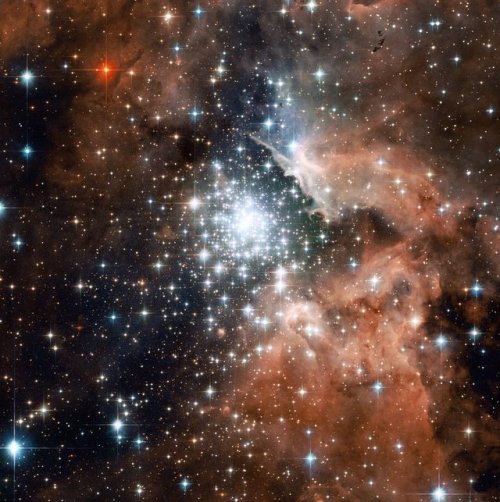
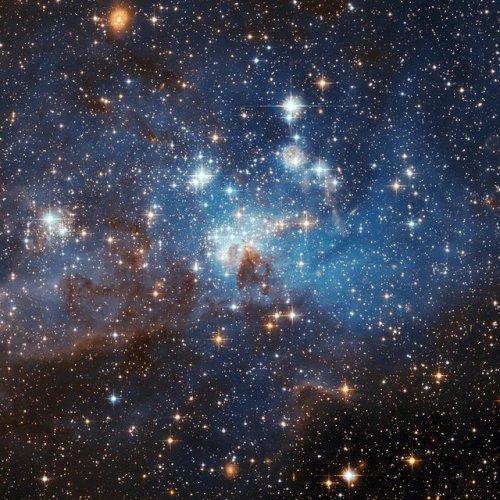
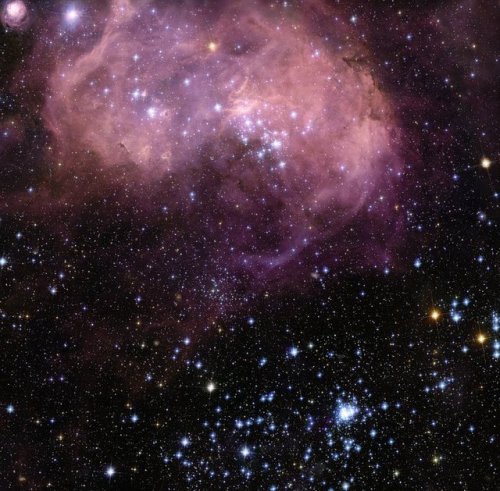
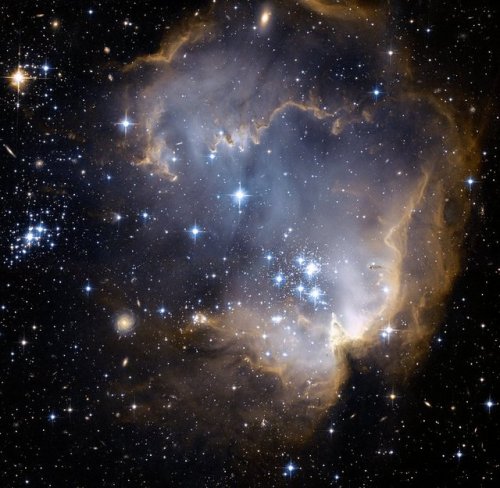
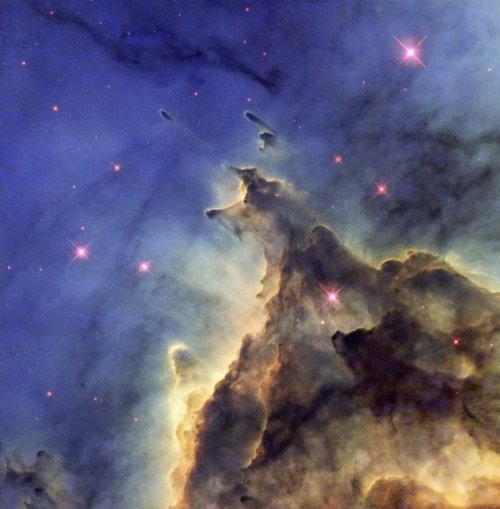
Star-forming regions amid gas and dust taken by the Hubble Space Telescope. (NGC 2467, NGC 3603, Star forming region in the Large Magellanic Cloud (LMC), N11, N90 and NGC 2174)
Image credit: NASA/ESA & Hubble
🍁🍂🎃

-
 inameenadika reblogged this · 1 year ago
inameenadika reblogged this · 1 year ago -
 legendaryhologramavenue reblogged this · 1 year ago
legendaryhologramavenue reblogged this · 1 year ago -
 inameenadika reblogged this · 1 year ago
inameenadika reblogged this · 1 year ago -
 hibiscus-blossom reblogged this · 1 year ago
hibiscus-blossom reblogged this · 1 year ago -
 crawlin-through-daisies reblogged this · 2 years ago
crawlin-through-daisies reblogged this · 2 years ago -
 crawlin-through-daisies liked this · 2 years ago
crawlin-through-daisies liked this · 2 years ago -
 pacificnorthpest reblogged this · 3 years ago
pacificnorthpest reblogged this · 3 years ago -
 cnstntngrg liked this · 4 years ago
cnstntngrg liked this · 4 years ago -
 somepassingthoughts reblogged this · 4 years ago
somepassingthoughts reblogged this · 4 years ago -
 spookyanxietygirl liked this · 4 years ago
spookyanxietygirl liked this · 4 years ago -
 claudiakc1968 liked this · 4 years ago
claudiakc1968 liked this · 4 years ago -
 voxxvoxx liked this · 4 years ago
voxxvoxx liked this · 4 years ago -
 bowserbot49 liked this · 4 years ago
bowserbot49 liked this · 4 years ago -
 only-desire-is-happiness liked this · 4 years ago
only-desire-is-happiness liked this · 4 years ago -
 balenct liked this · 4 years ago
balenct liked this · 4 years ago -
 nv-ace liked this · 4 years ago
nv-ace liked this · 4 years ago -
 autumnalpleasures reblogged this · 4 years ago
autumnalpleasures reblogged this · 4 years ago -
 treasuredthings reblogged this · 4 years ago
treasuredthings reblogged this · 4 years ago -
 chillinyan liked this · 4 years ago
chillinyan liked this · 4 years ago -
 niceone-doubleohseven liked this · 4 years ago
niceone-doubleohseven liked this · 4 years ago -
 vinu1991-blog liked this · 4 years ago
vinu1991-blog liked this · 4 years ago -
 primontagnerblog liked this · 5 years ago
primontagnerblog liked this · 5 years ago -
 captain-rubeus reblogged this · 5 years ago
captain-rubeus reblogged this · 5 years ago -
 captain-rubeus liked this · 5 years ago
captain-rubeus liked this · 5 years ago -
 bumpadeer liked this · 5 years ago
bumpadeer liked this · 5 years ago -
 kabernathy28 liked this · 5 years ago
kabernathy28 liked this · 5 years ago -
 kauskober reblogged this · 5 years ago
kauskober reblogged this · 5 years ago
My ambition is handicapped by laziness. -C. Bukowski Me gustan las personas desesperadas con mentes rotas y destinos rotos. Están llenos de sorpresas y explosiones. -C. Bukowski. I love cats. Born in the early 80's, raised in the 90's. I like Nature, Autumn, books, landscapes, cold days, cloudy Windy days, space, Science, Paleontology, Biology, Astronomy, History, Social Sciences, Drawing, spending the night watching at the stars, Rick & Morty. I'm a lazy ass.
222 posts